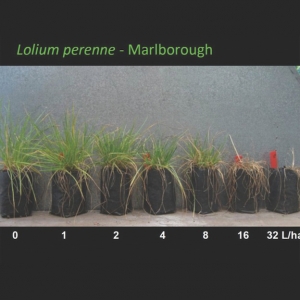Yet resistance to glyphosate is growing, with 25 species around the world now resistant, compared with zero in 1995.
This growing resistance is of concern to all involved in viticulture, given how much of it is used and how often.
Nick Pike, the Chief Executive of the Foundation for Arable Research, said ryegrass resistance is a particular concern, with New Zealand being the second country in the world to have recorded resistance in lolium multiflorum (Italian ryegrass or annual ryegrass).
Removing this and perennial ryegrass from vineyards has often been a common practice, as growers attempt to clear away competing species beneath vines.
Pike said that the research being undertaken on glyphosate resistance, has been studying the impact of glyphosates on perennial ryegrass in Marlborough.
“In this project the scientists grew out some lolium multiflorum plants and exposed them to different rates of glyphosates. The plants continued to grow quite happily at 4 litres per hectare. At 8 litres we still had ryegrass surviving and you wouldn’t want to be using glyphosates at that level. If we look at perennial ryegrass, except at 2 and 4 litres per hectare, the growth is slightly stunted and at 8 litres it’s still alive. At 16 litres there is still a bit of green there, so this variety is very tolerant to high rates of glyphosates.”
See photo.
In terms of how a plant gains resistance, Pike said there is generally an alteration of the translocation within the plant.
“So instead of the glyphosates moving to the growing point it moves into a vacuoles and is stored. That is the early stage of resistance that has been picked up. There are two other types of resistance. The target site mutations and the gene amplification.”
These resistant mechanisms don’t all occur in the same manner, but they do all come about as a result of repeat uses of glyphosates.
“So that five, six or 15 years
of glyphosate may take place before you see resistance occurring.”
Anywhere you are using glyphosates to create weed free strips is going to be high risk, Pike said. But there are ways to avoid resistance.
“You need to make sure you are looking. If you think a plant should have been killed and it hasn’t, go back and get rid of it. That’s number one. Number two is to avoid overuse of glyphosates. Wherever you can, mix something else in that will also control the weeds. Or rotate glyphosate. Use another product. There are other options such as mowing, grazing, cultivation or rouging that you could consider.”
Pike said we don’t have the luxury of saying we have these chemicals at our disposal as we move forward, if more plants become resistant.
“We need to make sure we use them wisely to ensure we have the ability to use these chemicals in the future.” ν
This email address is being protected from spambots. You need JavaScript enabled to view it.










